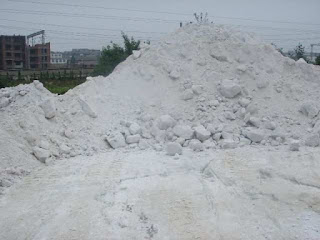Which devices are used for size reduction of mineral?
In
practice, size reduction of mineral particle assemblies is accomplished
stepwise in commercial devices. The complicating features in the breakage of
large assemblies of particles are the different particle sizes and strengths
and the sometimes random way in which stress is applied in the various steps.
In mining operations, blasting with explosives is usually the first step in the
comminution sequence. During blasting, high-velocity gas pressure pulses
created by the explosives load blocks of ores to provide initial fragmentation.
The next step in mineral processing plant is typically crushing, which is
accomplished by slow compression of large particles (greater than 1 cm) against
rigid surfaces. The mechanism of breakage in the crushing step is contrasted
with subsequent size reduction by tumbling or stirred mills in which breakage
of smaller particles (less than 1 cm) is accomplished by a combination of
impact, chipping, and abrasion events caused by energy transferred from grinding
media, such as balls, rods, or large particles. The characteristics of the
product required in a given application determines what device or series of
devices is required.
Crushing
is performed in one or more stages with small reduction ratios, (d80 F /d80 P is between 3 and 6 per stage). Practically
speaking, the reduction ratio represents the ratio of feed size opening (the gape) to the discharge size opening (the set). The
first stage, primary crushing(ie jaw crusher, gyratory crusher ), usually produces a
product that contains particles finer than 10 cm with an attendant energy
consumption of less than 0.5 kWh/t. The energy
efficiency is on the order of 80%. Secondary crushing can generally achieve size reduction to less than 1 cm with an energy
consumption of less than 1.0 kWh/t. Here the
efficiency is closer to 50%. The next stage
of size reduction for most mineral processing operations is accomplished by wet grinding in rotating cylindrical vessels termed “tumbling
mills.” In these mills, particle breakage occurs by compression, chipping, and abrasion caused by the tumbling action of
the grinding media. Preliminary grinding can be
done with a rod mill, in which case the grinding media consists of an
assortment of rods, a ball mill using balls, an
autogenous mill that uses no grinding media, or a semiautogenous mill that uses
a light load of balls. The product from primary grinding can be as fine as 300 μm.
The energy required can be between 5.0 and 25.0 kWh/t
depending on the ore and the product size. The energy efficiency of these devices ranges from 15% down to 3%. Sometimes a
special crusher called a high-compression
grinding roll is used at this stage; it has an efficiency of up to 30%.
Final
stages of grinding are normally accomplished in tumbling ball mills or stirred
mills. Here it is possible to reach product sizes of a few microns but at costs
of as much as 50 kWh/t. In this case, the energy efficiency may drop to as low
as 1% when based on the energy for single-particle slowcompression loading..
In this
section descriptions of different types of comminution devices are given
together with specific design criteria and operating characteristics. For the
past quarter century, the size of comminution equipment and associated drives
required for commercial-scale comminution tasks has been selected on the basis
of the specific energy (energy per unit mass of product) necessary to reduce a
feed material to the desired product size. The choice of specific energy as a
scale-up criterion is based
on two
important premises: (1) equipment of different sizes delivering the same
specific energy will yield
identical products when fed the same feed material, and (2) existing equipment
size/power draft relationships
are accurate enough to allow an equipment size that will deliver the necessary
energy at the design throughput to be selected.
Whenever
possible, the specific energy requirement for a given feed to product
transformation is determined in such a way as to minimize the design risk. In
other words, the value is determined from an existing full-scale operation or
from a pilot-plant circuit that is operated in a fashion similar to that anticipated
for the commercial installation. When commercial- or pilot-scale data are not
available, design engineers often use the Bond energy size reduction equation,
or its equivalent, to estimate specific energy requirements. Recently other
techniques involving population balance model parameters have been shown to
reduce design risk.

评论
发表评论